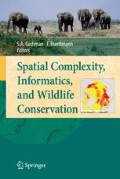Abstract
One of Africa's greatest conservation successes is the recovery of elephant (Loxodonta africana) populations within protected areas (e.g. Aleper and Moe 2006), such as those in northern Botswana. This recovery poses several challenges, however. First, habitat within protected areas is becoming degraded from high intensity elephant browsing. Second, the increasing elephant and human populations in the region have led to large increases in human—elephant conflict along the periphery of protected areas (Sitati et al. 2005; Lee and Graham 2006). Management options include facilitating natural dispersal, active relocation, and culling. Relocation is prohibitively expensive as a population-level solution given the high per capita cost. Culling is politically unpopular given Botswana's booming wildlife tourist industry. Simultaneously, large areas of the neighboring countries of Namibia, Zambia and Angola have low elephant densities. Some of these governments desire to increase elephant populations within their protected areas to promote the growth of wildlife tourism. Thus, facilitated dispersal of elephants from high density areas of northern Botswana to protected areas in other countries with low elephant densities is an attractive potential solution.
Access this chapter
Tax calculation will be finalised at checkout
Purchases are for personal use only
Preview
Unable to display preview. Download preview PDF.
References
Aleper D, Moe SR (2006) The African savannah elephant population in Kidepo Valley National Park, Uganda: changes in size and structure from 1967 to 2000. Afr J Ecol 44:157–164
Chamaille-Jammes S, Valiex M, Fritz H (2007) Managing heterogeneity in elephant distribution: interactions between elephant population density and surface-water availability. J Appl Ecol 44:625–633
Chamaille-Jammes S (2006) Under the African sky: from climatic fluctuations to the regulation of populations, the role of surface-water in the spatio-temporal dynamics of a large elephant population. Ph.D. Thesis, University Pierre et Marie Curie, Paris
Compton BW, McGarigal K, Cushman S, Gamble L (2007) A resistant-kernel model of connectivity for amphibians that breed in vernal pools. Conservat Biol 21:788–799
Cushman SA, Chase M, Griffin C (2005) Elephants in space and time. Oikos 109:331–341
Cushman SA, McKelvey KS, Hayden J, Schwartz MK (2006) Gene flow in complex landscapes: testing multiple hypotheses with causal modelling. Am Nat 168:486–499
Cushman SA, McKelvey KS, Schwartz MK (2009) Identifying corridors for the movement of black bear (Ursus americanus) between Yellowstone National Park and the Canadian Border. Conservat Biol 23:368–376
ESRI (2005) ArcInfo Workstation. ESRI, Redlands, California
Fortin M-J, Dale M (2005) Spatial analysis: a guide for ecologists. Cambridge University Press, Cambridge
Lee PC, Graham MD (2006) African elephants Loxodonta Africana and human-elephant interactions: implications for conservation. Int Zoo Yearbk 40:9–19
Levin SA (1992) The problem of pattern and scale in ecology. Ecology 73:1943–1967
Murwira A, Skidmore AK (2005) The response of elephants to the spatial heterogeneity of vegetation in a Southern African agricultural landscape. Landsc Ecol 20:217
Osborn F V, Parker GE (2003) Linking two elephant refuges with a corridor in the communal lands of Zimbabwe. Afr J Ecol 41:68–74
Siati NW, Walpole MJ, Leader-Williams N (2005) Factors affecting susceptibility of farms to crop raiding by African elephants: using a predictive model to mitigate conflict. J Appl Ecol 42:1175–1182
Sitati NW, Walpole MJ, Smith RJ, Leader-Williams N (2003) Predicting spatial aspects of human-elephant conflict. J Appl Ecol 40:157–164
Wiens JA (1989) Spatial scaling in ecology. Funct Ecol 3:385–397
Author information
Authors and Affiliations
Corresponding author
Editor information
Editors and Affiliations
Rights and permissions
Copyright information
© 2010 Springer
About this chapter
Cite this chapter
Cushman, S.A., Chase, M., Griffin, C. (2010). Mapping Landscape Resistance to Identify Corridors and Barriers for Elephant Movement in Southern Africa. In: Cushman, S.A., Huettmann, F. (eds) Spatial Complexity, Informatics, and Wildlife Conservation. Springer, Tokyo. https://doi.org/10.1007/978-4-431-87771-4_19
Download citation
DOI: https://doi.org/10.1007/978-4-431-87771-4_19
Publisher Name: Springer, Tokyo
Print ISBN: 978-4-431-87770-7
Online ISBN: 978-4-431-87771-4
eBook Packages: Biomedical and Life SciencesBiomedical and Life Sciences (R0)

